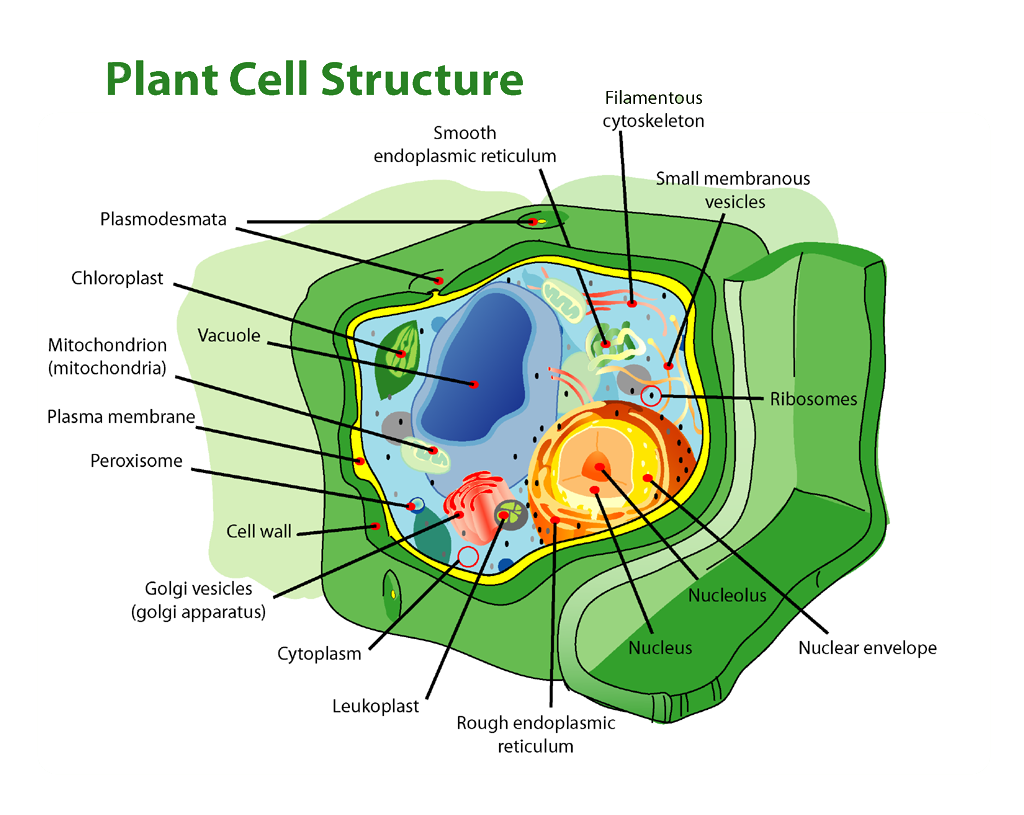Cell Wall
It is the outermost covering of the cell and encloses the cytoplasm and the vacuole. The primary cell wall is a permeable flexible structure and is capable of elongation. It is composed of long chains of cellulose molecules, which are embedded in a matrix of a mixture of hemicellulose and pectic substances. As the cell matures, the flexibility of the primary cell wall reduces gradually due to deposition of various hardening substances on its inner surface. This deposition process gives rise to different types of walls around cells of different plant organs. They are briefly described below.

Image Source: wikipedia.org
Types of Cell wall
Different types of cell walls can be recognized according to the chemical substances that modify the primary cell wall depending on the position, function, and age of the cells. Chemical composition of the cell walls of various plant tissues often furnishes important chemo—microscopical characters, which can be used in the identification of the plant drugs and detection of adulterants in them. Various chemical substances are deposited or encrusted on the cell walls at different stages of their growth bringing about some changes in their structures and characters. These changes on any given cell wall are often designated by the principal chemical substance that forms the wall or modifies it. The following types of cell wall are recognized in the plant cells.
Cellulosic wall
The basic framework of the primary cell wall is composed of chains of cellulose molecules embedded in a matrix of mixtures of hemicellulose and pectic substances. Molecules of cellulose are made up of up to 300 to 2500 units of 1:4C-linked glucose units in straight chains. Cellulose cell walls can be recognized by the use of certain chemical reagents. For example, solution of Chlor-zinc–iodine gives a blue color with true cellulose. Ammoniacal solution of copper oxide (CUOXAM) dissolves true cellulose, and when the alkaline liquid is poured into dilute sulphuric acid the cellulose is precipitated.
The hemicellulose, forming the ground substance (matrix) of the Primary cell wall along with pectin, is an amorphous carbohydrate made up of various sugar units including glucose, pentoses and uronic acids. When treated with Iodine solution hemicellulose gives a blue color. It dissolves in NaOH (17.5%) and KOH (24%) solutions and stains pink with Ruthenium red solution. Pectic substances are similar am0rph0us carbohydrates and are usually methoxy derivatives. They are hydrophilic in nature and maintain flexibility of the young cell wall. Like hemicellulose, they are also soluble in the alkalis. They give blue color with methylene blue and yellow with Chlor-zinc-iodine solution.
As the cell matures the cell wall looses its flexibility and secondary depositions of various chemical substances occur on the inner surface of the primary wall. These depositions result in the formation of a secondary (or modified) cell wall, which adds strength to the primary wall to increase its mechanical strength and modify or change some of its physical and chemical properties. The secondary cell walls consist of 1 to 3 layers and are variously named as follows.
Lignified wall
When a cell wall is impregnated with lignin it is called a lignified cell wall. Cells with lignified walls are dead and constitute the mechanical and water-conducting tissues, such as tracheids, fibers, sclereids and vessels of vascular plants. A strengthening chemical substance, lignin is a complex phenylpropanoid (C6-C3) polymer with -0-CH3 and -OH groups. In the cell wall, it appears to occur chemically combined with hemicellulose.
Lignified cell walls stain bright yellow when treated with Aniline hydrochloride solution, permanent red with Safranin solution and yellow or deep brown with Chlor-zinc-iodine. Treatment with phloroglucinol followed by concentrated hydrochloric acid stains lignified walls pink or reddish violet.
Suberised and cutinised walls
The cellulosic frameworks of many plant cells are adcrusted with suberins and cutins. These are hydrophillic substances that make cell walls impermeable to water, prevent dehydration of cells and form a good thermal insulation of the cell wall. Suberin and cutin consist of oxidized and polymerized fatty acids and their esters. They differ from each other in the type of the acid, degree of esterification and polymerization.
Aqueous sodium hydroxide solution (3%) dissolves and saponifies suberin, while methanolic potassium hydroxide solution (3%) dissolves and saponifies cutin. Both of them give red color with Sudan IV and Tincture of alkanna, and brown or yellow color with Chlor-zinc-iodine.
Mucilaginous wall
Certain cell walls are sometimes adcrusted or covered with gums and mucilage. These substances possess slimy properties and contain mixtures of polysaccharides and polyuronides, formed from cellulose or pectic substances. When treated with aqueous potassium hydroxide solution, mucilaginous cell walls swell. They stain blue or purple with Chlor-zinc-iodine, pink with Ruthenium red and red with Corallin soda.
Waxy wall
Cell walls with waxy covering occur in the epidermal cells of some leaves and fruits and provide water repulsing properties to them. Wax consists of esters or mixtures of aliphatic wax alcohols (CH3 (CH2)nCH2OH; n=22 to 32) and corresponding fatty acids.
Callose wall
Certain cell walls are covered with a membranous adcrusting carbohydrate substance, called callose. It is composed of a kind of hemicellulose, which is a polymer of Beta-glucose units linked by 1:3 carbon atoms. Callose is soluble in 5% alkali solutions and stains red with Corallin soda, and blue with Aniline blue.
Chitinous wall
Cell walls of crustaceans, insects and many fungi (e.g. Ergot) are made up of chitin (C6H13O5N)n. Chitinous cell walls give no reactions for cellulose or lignin. When heated with 50% potash at 160 to 170°C for lhour, chitin changes to chitosan, ammonia and acids. Chitosan gives a violet colour when treated first with a 0.5% solution of iodine in potassium iodide and then wit1;11 % sulphuric acid. Defatted Ergot gives this test.
Tannins and silica also rarely adcrust on to cell walls of some plants.
